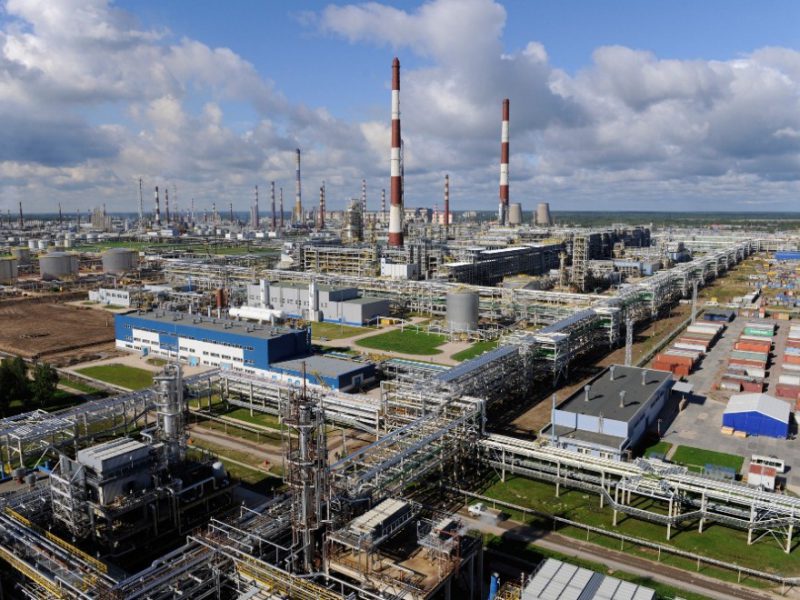Nine months. That’s how long Russia admits it needs to solve what officials call a “temporary” fuel crisis.
The self-proclaimed energy superpower agreed on 30 September to suspend all fuel import tariffs through June 2026—a humiliating admission that Ukrainian drone strikes and Western sanctions have broken its refining capacity. Russia now bans fuel exports while simultaneously preparing to import from smaller neighbors.
Russian refineries hit record shutdown rates
As of 28 September, 38% of Russia’s primary oil refining capacity stood idle—some 338,000 tons per day—according to data from Russian analytical agency Siala. That’s the highest idle capacity on record, exceeding even the previous high of 23% in August.
The shutdowns have created a fuel deficit of roughly 400,000 tons out of 2 million tons monthly—about 20% of total consumption.
A source familiar with supply balances told Russian newspaper Kommersant the situation is critical.
Wholesale gasoline prices have jumped over 40% since January, with AI-92 grade reaching 73,600 rubles ($880) per ton and AI-95 trading at 71,100 rubles ($850) on 29 September, according to St. Petersburg International Mercantile Exchange data cited by The Moscow Times.
According to Russia’s Independent Fuel Union, over 20 regions face fuel shortages, from Sakhalin and Chukotka in the Far East to Ryazan and Samara oblasts in central Russia. Annexed Crimea and Sevastopol have imposed 30-liter purchase limits, while some regions restrict sales to 10-20 liters per customer. Major producer Lukoil has banned canister sales at some Moscow stations.
On 25 September, Deputy Prime Minister Alexander Novak announced Russia would extend its gasoline export ban through year-end and impose diesel export restrictions.
“The overall balance for both September and October is difficult,” Novak admitted to state media.
Western sanctions make repairs impossible
So how did the supposed energy superpower end up begging neighbors for fuel?
The nine-month duty suspension reflects a harsh reality: Western sanctions transformed routine refinery maintenance into structurally impossible repairs.
According to Russian industry sources who spoke to Reuters, Western companies such as US-American UOP and Swiss engineering group ABB supplied technology and software to Russia’s 40 biggest refineries over the last two decades.
Both companies stopped taking new orders from Russia after the February 2022 invasion. Refining equipment is far more specialized than consumer goods, making it nearly impossible for Russia to obtain spare parts through third countries despite attempts to find workarounds.
“Just like you can’t replace a faulty clutch in a BMW with a similar part from a Russian-made Lada, the same applies in industry,”
explained Sergei Vakulenko, a Carnegie Endowment energy analyst.
Russian and Chinese factories produce some equipment, but integrating non-original parts creates cascading problems. Technical and regulatory approval issues extend repairs from weeks to months or longer.
Ukrainian drone campaign compounds pressure
The crisis stems from Ukraine’s intensified strikes on Russian oil infrastructure since August. Ukrainian forces have damaged at least six major refineries, including the Ryazan facility (one of the five largest in Russia), the Kinef plant in Leningrad Oblast (Russia’s second-largest by capacity), and facilities in Saratov, Samara, Volgograd, and Astrakhan.
“This is a fuel crisis in Russia, which directly affects logistics and the supply of its army,” Ukrainian Commander-in-Chief Oleksandr Syrskyi stated on 26 September.
Ukraine’s General Staff revealed in mid-August that 42% of its long-range strikes since January targeted oil refineries, making them the most frequently hit target category.
The ongoing campaign has knocked out 38% of Russian refining capacity, up from 13.5% in mid-August.
The combination of continuing Ukrainian strikes and sanctions-hampered repairs means damaged facilities remain offline for months, creating the structural supply deficit that prompted the nine-month duty suspension.
Belarus to the rescue—for a steep price
The tariff suspension enables imports from Eurasian Economic Union partners, particularly Belarus, but Moscow paid a steep price.
In late August, Ukraine’s Foreign Intelligence Service predicted that Belarus would restrict fuel supplies to Russia despite surging demand. The economic logic was clear: international markets pay $1,300-1,900 per ton for Belarusian gasoline, while Russia offers less than $1,000.
Belarusian refineries have an annual production capacity of only 3-4 million tons of gasoline, with 2 million tons consumed domestically, while Russia consumes 3 million tons of gasoline in one month alone.
Yet by September, Belarus dramatically reversed course.
According to Russian outlet RBC, from July through September, nearly 97,000 tons of Belarusian petroleum products were sold through the St. Petersburg Exchange. That’s a 36% increase compared with the same period in 2024.
In September alone, gasoline shipments from Belarusian refineries jumped 168% month-over-month, while diesel sales rose 83%, Belarusian opposition outlet Pozirk reported.
Belarus flipped exactly when Russia made a significant concession.
During a 26 September meeting at the Kremlin, Belarusian President Alyaksandr Lukashenka proposed building a second nuclear power plant in eastern Belarus.
“The issue of financing is not a problem at all. If there are consumers who will use the electricity and pay the tariffs, it’s not a problem in the slightest,” Russian President Vladimir Putin responded, giving the proposal public backing.
The first Belarusian nuclear power plant in Astravets near the Lithuanian border, built by Rosatom from 2012 to 2021, cost $11 billion in Moscow-provided loans. Now Minsk has extracted a second such commitment. Putin’s backing for the new plant came on 26 September—just four days before the 30 September EAEU tariff suspension announcement.
Despite poor economics, Belarus then flooded Russia with fuel, having secured another multi-billion dollar infrastructure project as payment.
Energy superpower’s decline
The nation that built its geopolitical identity on energy dominance now depends on imports from its smaller neighbor—paying with costly infrastructure commitments to secure those supplies.
The nine-month timeline Moscow announced signals that Russia expects no quick resolution.
With Ukrainian strikes continuing and sanctions making repairs structurally impossible, Russia faces a fuel crisis extending well into 2026.
Even Russia’s closest ally now benefits from Moscow’s dependence—Minsk negotiated an $11 billion nuclear plant to sell Russia fuel. The energy superpower has become a supplicant.




